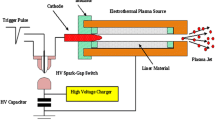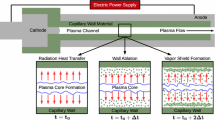Abstract
An ablation-dominated capillary discharge using low atomic number elements for plasma formation to flow into an ablation-free extension barrel is a concept that provides a high energy–density plasma flow sufficient to propel fuel pellets into the tokamak fusion plasma chamber. In this concept, the extension barrel is made from a non-ablating material by coating the interior wall of the barrel with nanocrystalline diamond to eliminate mixing the propelling plasma with any impurities evolving from the barrel ablation. The electrothermal plasma code ETFLOW models the plasma formation and flow in the capillary discharge and the flow into the extension barrel to accelerate frozen deuterium pellets. The code includes governing equations for both the capillary and the extension barrel, with the addition of the pellet’s terms. It also includes ideal and non-ideal plasma conductivity models. The joule heating term in the energy conservation equation is only valid in the capillary section. The pellet momentum and kinetic energy are included in the governing equations of the barrel, with the addition of the effect of viscous drag terms. The electrothermal capillary source generates the plasma via the ablation of a sleeve inside the main capillary housing. The acceleration of the pellet starts in the extension barrel when the pressure of the plasma flow from the capillary reaches the release limit. The code results show pellet exit velocities in excess of 2 km/s for source/barrel systems with low-Z liner materials in the source for 5, 20, 45, and 80 mg pellets. The study shows that an increase in the length of both the source and the extension barrel increases the pellet exit velocity with the limitation of slowdown effects for plasma expansion and cooling off inside the barrel.









Similar content being viewed by others
References
S.K. Comb, Pellet injection technology. Rev. Sci. Instrum. 64, 1679 (1993)
J.G. Salge, T.H. Weise, U.E. Braunsbeger, H.W. Fien, M.J. Loffler, W. Witt, D. Zwingel, K. Zocha, Mass acceleration by plasma pulses. IEEE Trans. Magn. 25, 495 (1989)
S.K. Combs, C.R. Foust, S.L. Milora, Small‐bore (1.8‐mm), high‐firing‐rate (10‐Hz) version of a repeating pneumatic hydrogen pellet injector. Rev. Sci. Instrum. 66, 2736 (1995)
F.D. Witherspoon, R.L. Burton, S.A. Goldstein, A second generation EMET railgun for secondary arc studies. IEEE Trans. Magn. 27, 91 (1991)
R.W. Kincaid, M.A. Bourham, Electrothermal plasma gun as a pellet injector. J. Fusion Technol. 26, 637 (1994)
E.Y. Shcolnikov, A.V. Chebotarev, Y.A. Kulikov, A.V. Melnik, S.V. Volkov, High efficiency electrothermal accelerator. IEEE Trans. Magn. 31, 447 (1995)
D.D. Schuresko, S.L. Milora, S.K. Combs, C.R. Foust, B.E. Argo, G.C. Barber, C.A. Foster, N.S. Ponte, Development of a hydrogen electrothermal accelerator for plasma fueling. J. Vac. Sci. Technol., A 5, 2194 (1987)
J.G. Gilligan, M.A. Bourham, The use of an electrothermal plasma gun to simulate the extremely high heat flux conditions of a tokamak disruption. J. Fusion Energ. 12, 311 (1993)
J.P. Sharpe, M.A. Bourham, J.G. Gilligan, Generation and characterization of carbon particulate in disruption simulations. Fusion Technol. 34, 634 (1998)
T. Edamitsu, H. Tahara, Experimental and numerical study of an electrothermal pulsed plasma thruster for small satellites. Vacuum 80, 1223 (2006)
K. Miyamoto, Plasma Physics for Nuclear Fusion (MIT Press, Cambridge, 1989)
A.A. Harms, K.F. Schoepf, G.H. Miley, D.R. Kingdon, Principles of Fusion Energy (World Scientific Publishing, Singapore, 2000)
G.K. Pitcher, Solid lithium hydryide as a hydrogen source for fuel cells. In Proceedings of 1996 symposium on autonomous underwater vehicle technology (AUV ‘96), Monterey, CA, USA, 2–6 June 1996, p. 455 (1996)
S.K. Combs, M.J. Gouge, L.R. Baylor, C.R. Foust, P.W. Fisher, S.L. Milora, A.L. Qualls, D.E. Schechter, J.M. Walters, Development of pellet injection systems for ITER. In Proceedings of 16th IEEE/NPSS symposium on fusion engineering (1995 SOFE), vol. 2, Champaign, IL, USA, Sep 30–Oct 5, 1995, p. 1607, IEEE (1995)
B.V. Kuteev, A.P. Umov, I.V. Viniar, G.A. Baranov, V.N. Skripunov, Pellet injection research and development program. Plasma Devices Oper. 2, 193 (1994)
M.J. Gouge, K.D. St. Onge, S.L. Milora, P.W. Fisher, S.K. Combs, Pellet fueling system for ITER. Fusion Eng. Des. 19, 53 (1992)
S.J. Meitner, L.R. Baylor, S.K. Combs, D.T. Fehling, J.M. McGill, D.A. Rasmussen, J.W. Leachman, Development of a twin-screw D2 extruder for the ITER pellet injection system. Fusion Sci. Technol. 56, 52 (2009)
S.K. Combs L.R. Baylor, C.R. Foust, M.J. Gouge, S.L. Milora, A. Frattolillo, M. Gasparotto, S. Migliori, F. Scaramuzzi, G. Angelone, M. Baldarelli, M. Capobianchi, C. Domma, G. Ronci, High-speed repetitive pellet injector for plasma fueling of magnetic confinement fusion devices. In Proceedings of 15th IEEE/NPSS symposium on fusion engineering, vol. 1, Hyannis, MA, USA, Oct 11–15, 1993, p. 48, IEEE (1993)
M. Onozuka, Y. Oda, K. Azuma, M. Ogino, S. Kasa, K. Hasegawab, Development of railgun pellet injector using a laser-induced plasma armature. In Proceedings of the 15th IEEE/NPSS symposium on fusion engineering, vol. 1, Hyannis, MA, USA, Oct 11–15, 1993, p. 52, IEEE (1993)
A.L. Winfrey, Nanocrystalline Diamond Deposition for Friction Applications. MS thesis, North Carolina State University, Raleigh, NC, USA (2007)
R.R. Chromik, A.L. Winfrey, J. Luning, R.J. Nemanich, K.J. Wahl, Run-in behavior of nanocrystalline diamond coatings studied by in situ tribometry. Wear 265, 477 (2008)
A. Erdemir, G.R. Fenske, A.R. Krauss, D.M. Gruen, T. McCauley, R.T. Csencsits, Tribological properties of nanocrystalline diamond films, Surface & Coatings Technology. In Proceedings of the 26th international conference on metallurgical coatings and thin films, vol. 120–121, 12–15 April 1999, p. 565 (1999)
C.S. Abreu, F.J. Oliveira, M. Belmonte, A.J.S. Fernandes, J.R. Gomes, R.F. Silva, CVD diamond coated silicon nitride self-mated systems: tribological behaviour under high loads. Tribol. Lett. 21, 141 (2006)
E.A. Ekimov, A.G. Gavriliuk, B. Palosz, S. Gierlotka, P. Dluzewski, E. Tatianin, Yu. Kluev, A.M. Naletov, A. Presz, High-pressure, high-temperature synthesis of SiC-diamond nanocrystalline ceramics. Appl. Phys. Lett. 77, 954 (2000)
J. Qian, T.W. Zerda, D. He, L. Daemen, Y. Zhao, Micron diamond composites with nanocrystalline silicon carbide bonding. J. Mater. Res. 18, 1173 (2003)
J.D. Hurley, M.A. Bourham, J.G. Gilligan, Numerical simulation and experiment of plasma flow in the electrothermal launcher SIRENS. IEEE Trans. Plasma Sci. 31, 616 (1995)
M.R. Zaghloul, M.A. Bourham, J.M. Doster, J.D. Powell, On the average electron-ion momentum transport cross-section in ideal and nonideal plasmas. Phys. Lett. A 262, 86 (1999)
M.R. Zaghloul, M.A. Bourham, J.M. Doster, Energy-averaged electron–ion momentum transport cross section in the born approximation and Debye–Huckel potential: comparison with the cut-off theory. Phys. Lett. A 66, 34 (2000)
L. Winfrey, J.G. Gilligan, A.V. Saveliev, M.A. Al-Halim, M.A. Bourham, A study of plasma parameters in a capillary discharge with calculations using ideal and non-ideal plasma models for comparison with experiment. IEEE Trans. Plasma Sci. 40, 843 (2012)
M.R. Zaghloul, M.A. Bourham, J.M. Doster, A simple formulation and solution strategy of the Saha equation for ideal and nonideal plasmas. J. Phys. D Appl. Phys. 33, 977 (2000)
A.L. Winfrey, M.A. Abd Al-Halim, J.G. Gilligan, A.V. Saveliev, M.A. Bourham, Modeling of an ablation-free electrothermal plasma pellet accelerator. Fusion Sci. Technol. 60, 480 (2011)
A.L. Winfrey, J.G. Gilligan, M.A. Bourham, A comparative study of different low-Z liner materials in an ablation-dominated electrothermal mass accelerator for fusion fueling. In Proceedings of 24th IEEE/NPSS symposium on fusion engineering (SOFE 2011), Chicago, IL. 26–30 June 2011, p. 33, IEEE (2011)
Acknowledgments
This work was supported by the Department of Mechanical and Aerospace Engineering and the Department of Nuclear Engineering, North Carolina State University through a combined research support.
Author information
Authors and Affiliations
Corresponding author
Rights and permissions
About this article
Cite this article
Winfrey, A.L., Gilligan, J.G. & Bourham, M.A. A Computational Study of a Capillary Discharge Pellet Accelerator Concept for Magnetic Fusion Fueling. J Fusion Energ 32, 227–234 (2013). https://doi.org/10.1007/s10894-012-9549-x
Published:
Issue Date:
DOI: https://doi.org/10.1007/s10894-012-9549-x




